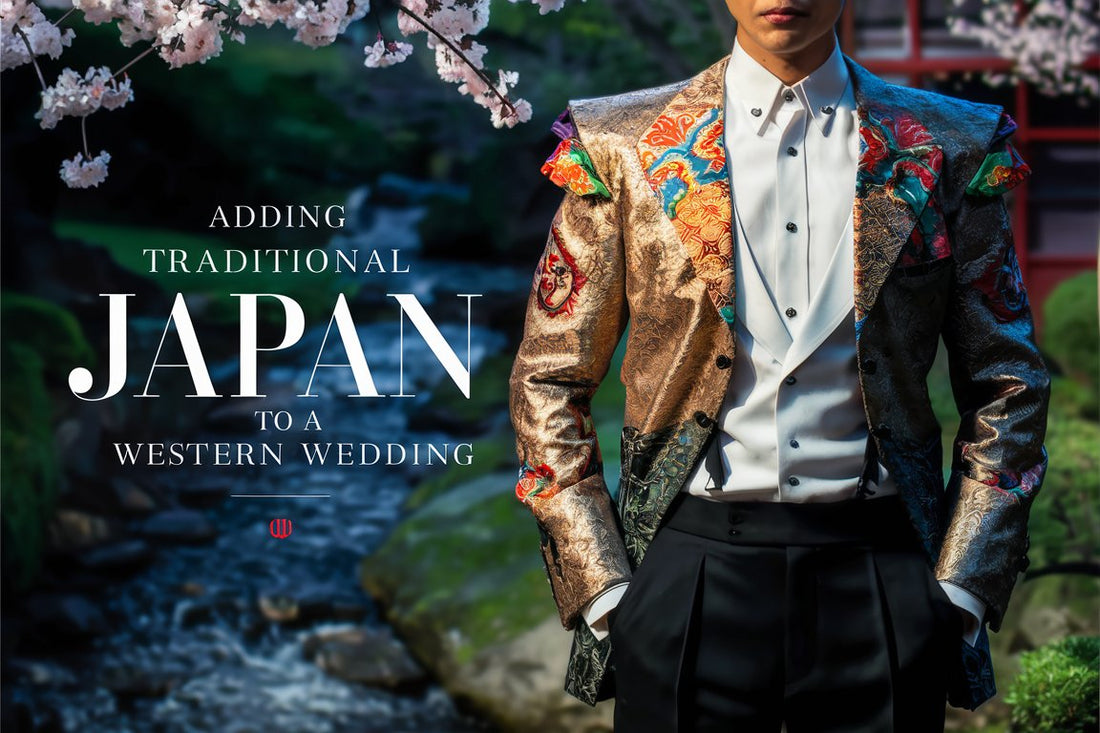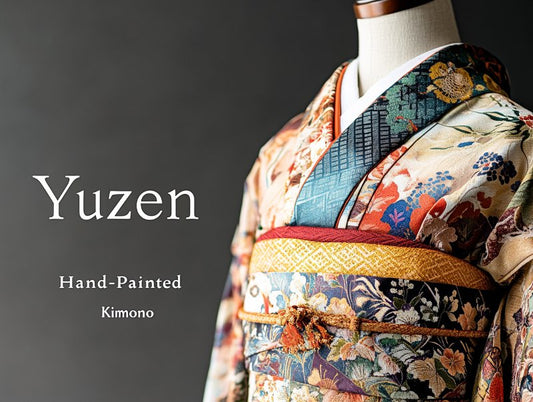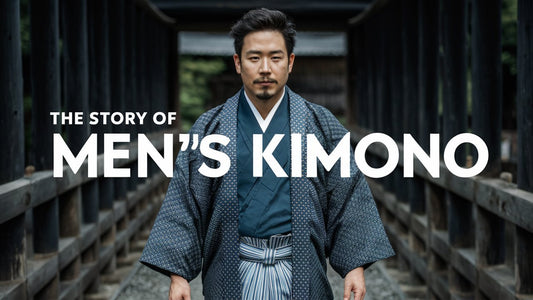
Japanese-Inspired Wedding Suits: Modern Men's Guide
Share
Weaving Cultures Together
Weddings symbolize the joining of paths, the fusion of histories, and the creation of a new, shared future. As couples seek to honor and integrate their diverse cultural backgrounds, one unique approach has emerged: incorporating traditional Japanese kimono fabrics into Western wedding attire, specifically men's suit jackets. This integration serves as a bridge between East and West, offering a distinct and meaningful aesthetic that honors tradition while embracing contemporary style.

Kimono Fabric: A Canvas of Tradition and Meaning
Kimono fabrics are renowned for their rich colors, intricate patterns, and deep cultural significance. Each motif, from cranes (symbols of longevity) to bamboo (representing strength and growth), carries a story, transforming garments into narratives. Understanding these symbols allows couples to choose fabrics that resonate with their personal stories and aspirations for their shared future.

In traditional Japanese weddings, the choice of kimono is a critical decision, reflecting the wearer's family history and the occasion's solemnity. By integrating these fabrics into Western-style weddings, couples can pay homage to this tradition, creating a unique and respectful cultural homage that adds depth and significance to their wedding attire.

Sustainability and Ethical Fashion: Repurposing with Purpose
The movement toward sustainable fashion has found a strong ally in the practice of repurposing vintage kimono fabrics. These textiles, often handcrafted with techniques passed down through generations, find new life in modern garments, promoting eco-friendly fashion choices while preserving historical artistry.

Beyond environmental benefits, using vintage kimono fabrics serves as a testament to the enduring beauty and relevance of traditional crafts. Couples who choose these materials for their wedding attire are not only making a fashion statement but also contributing to the preservation and appreciation of cultural heritage.
Styling Kimono Fabric Jackets: A Guide for Grooms and Guests
Incorporating kimono fabric into a Western suit jacket offers a unique opportunity to stand out while paying homage to Japanese aesthetics. For grooms, this can mean a striking, patterned jacket that becomes the centerpiece of the wedding attire. For guests, it might involve subtler touches, such as a kimono fabric waistcoat or tie, adding a splash of culture and color to their ensemble.

When styling these garments, balance is key. The vivid patterns and colors of kimono fabrics can be harmonized with classic wedding attire elements, creating an ensemble that respects both cultures' sartorial traditions. This section offers tips and examples on achieving a cohesive look that honors the fabric's legacy while fitting seamlessly into the wedding's overall aesthetic.
-
Start with a Focal Point: Choose one kimono fabric garment, such as the jacket, as the standout piece. Keep other elements more subdued to avoid overwhelming the look.
-
Color Coordination: Match one or two colors from the kimono fabric with the rest of the wedding attire to create a harmonious palette. This could be a tie, a pocket square, or even shoe laces.
-
Fabric Balance: If the kimono fabric is particularly bold, pair it with more understated textures and materials for the rest of the outfit to maintain balance.
-
Cultural Accessories: Introduce Japanese accessories sparingly. A traditional kanzashi (hair ornament) or a sensu (folding fan) can add authentic touches without overdoing it.
-
Modern Tailoring: Ensure the kimono fabric garment fits well within the context of Western tailoring standards – a well-fitted suit jacket made from kimono fabric can blend traditions beautifully.
-
Subtle Motifs: Opt for kimono patterns that are meaningful but not overly loud. Subtle designs can be more versatile and appropriate for a variety of wedding settings.
-
Consultation: If possible, consult with a stylist familiar with both Japanese and Western fashion to ensure cultural elements are integrated respectfully and tastefully.
-
Dress Code Communication: If incorporating Japanese elements significantly influences the wedding's dress code, communicate this clearly to guests to ensure coherence and respect for the theme.
-
Fabric Care: Ensure the kimono fabric, especially if vintage, is properly cared for before and after the event to preserve its beauty and significance.
-
Personal Comfort: Ultimately, make sure the groom feels comfortable and confident in his attire – the outfit should reflect his personality and the significance of the occasion.
By following these tips, the wedding attire can become a thoughtful blend of Japanese tradition and Western style, creating a memorable and respectful celebration.
Find your Kimono Blazer HereMindful Integration: Respecting Cultural Significance
While the integration of kimono fabrics into Western weddings is a beautiful way to honor Japanese culture, it's important to approach this fusion with respect and understanding. This involves not only choosing fabrics and designs that reflect the couple's connection to the culture but also ensuring that their use respects the kimono's cultural and historical significance.

Preserving Beauty: Caring for Kimono Fabric Attire
Kimono fabrics, especially those crafted from silk, require careful handling to maintain their beauty and integrity. This section provides essential tips for cleaning, storing, and maintaining kimono fabric garments, ensuring they remain pristine for years to come. From avoiding prolonged exposure to sunlight to understanding the proper techniques for ironing delicate silk, these guidelines help couples preserve the material's quality and significance.
Care Guide for Kimono Fabric Garments
Step 1: Gentle Washing Methods
- Hand wash in cold water with a mild, pH-neutral soap.
- Gently swirl the fabric in the water; do not wring or scrub.
- Rinse thoroughly with cold water until all soap is removed.
Step 2: Drying Techniques
- Lay the garment flat on a clean, dry towel.
- Roll the towel and garment together to remove excess water.
- Unroll and lay the garment flat on a second dry towel, away from direct sunlight and heat.
Step 3: Ironing Kimono Fabric
- Set the iron to the 'silk' setting or the lowest heat.
- Place a pressing cloth between the iron and the fabric.
- Gently iron the fabric, avoiding heavy pressure.
Step 4: Proper Storage
- Fold the garment along its original creases.
- Wrap in a clean, dry, unbleached cotton cloth.
- Store in a cool, dry place away from direct sunlight.
Step 5: Seasonal Care and Long-term Preservation
- Air out the garment periodically in a shaded, well-ventilated area.
- Check regularly for signs of moth activity or mildew.
- Consider professional cleaning every few years to maintain the fabric's integrity.
Following these steps will help ensure the longevity and beauty of your kimono fabric garments, preserving their quality and significance for years to come.
Celebrating Unity Through Fabric
The use of kimono fabric in Western weddings is more than a style choice; it's a statement of unity, respect, and shared beauty. By thoughtfully integrating these traditional textiles into modern celebrations, couples create a visual and symbolic link between their cultures, celebrating their union's unique blend of histories and futures.



